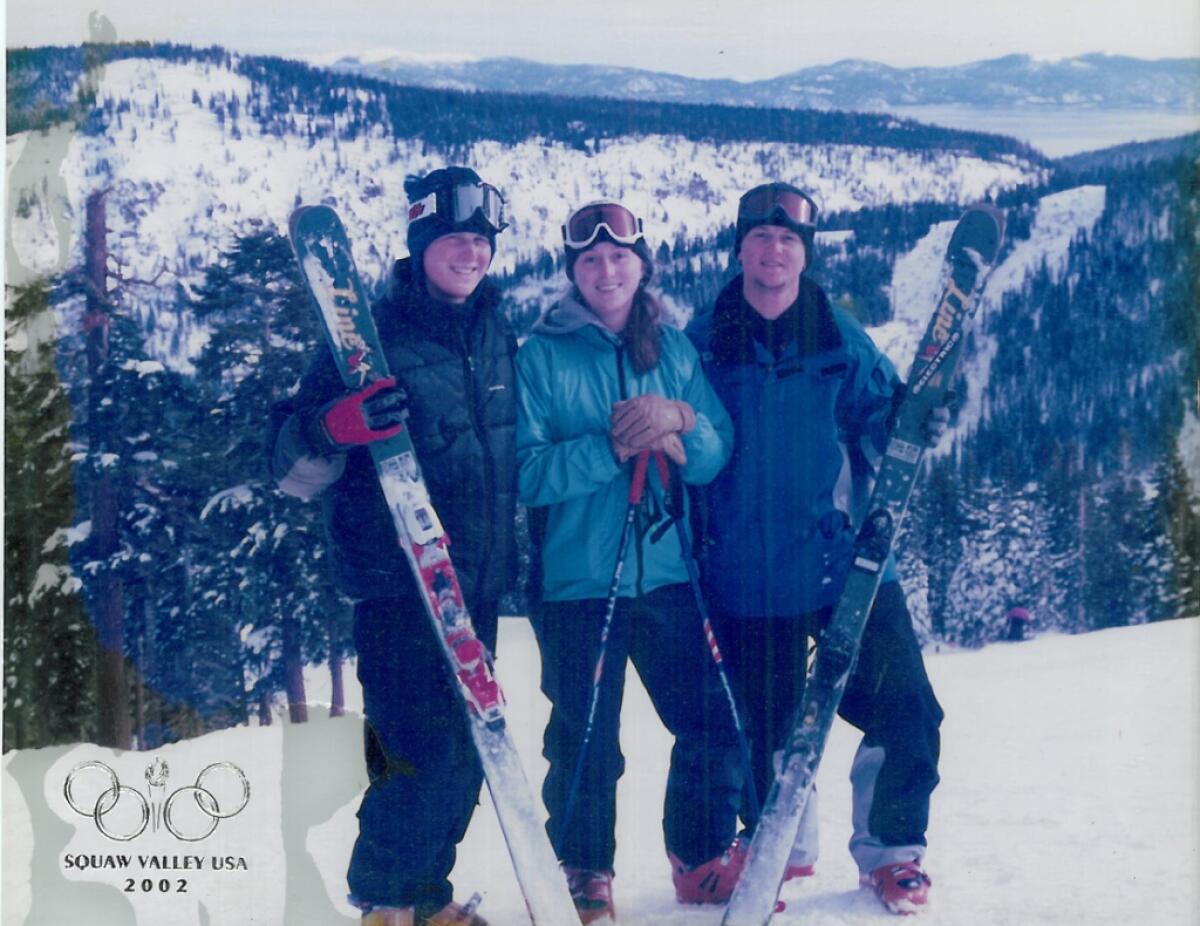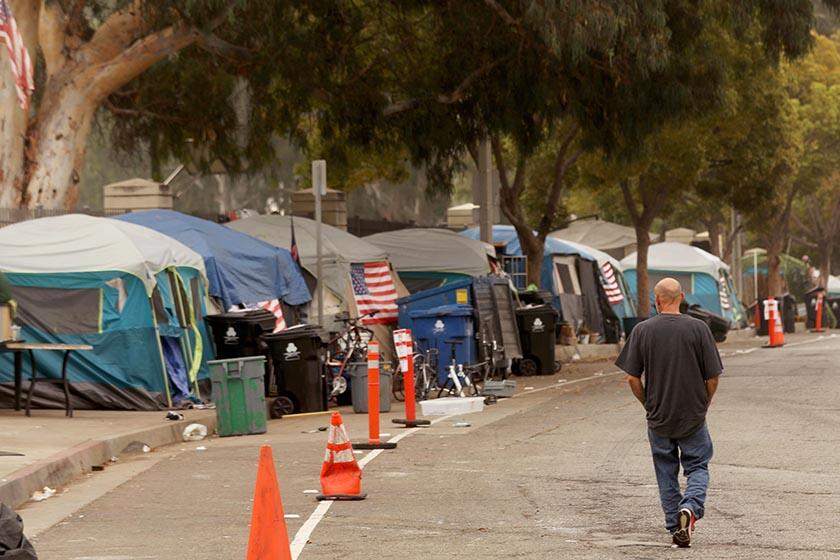Newsom’s plan seeks to give hope to families of mentally ill, homeless Californians

- Share via
Brian Lungren and his family wonder what could have spared him some of the 13 years he spent at Napa State Hospital in treatment for mental illness and serious drug and alcohol addiction.
Since Brian, or Bri to his family, was diagnosed as a teenager with schizoaffective disorder, bipolar type, his parents tried everything to save him from a years-long and emotionally painful spiral into drug use, incarceration and homelessness.
His dad, Brian Lungren Sr., tallied nine temporary and involuntary psychiatric holds, and up to three failed attempts at court-ordered conservatorship.
It was only after a judge found Brian not guilty by reason of insanity for stabbing another patient with a butter knife at an Auburn treatment center in 2007 that the family felt hopeful for his eventual recovery. Brian was sent to Napa State Hospital in 2008, after languishing in county jail for several months.
“We tried to get him the best help possible. But we had no recourse,” Lungren Sr. said.
Similar stories influenced Gov. Gavin Newsom’s decision this year to introduce a sweeping proposal to order mental health and addiction treatment for thousands of Californians, dubbed the Community Assistance, Recovery and Empowerment (CARE) Court.
On Wednesday, Newsom signed the proposal into law.

Gov. Gavin Newsom signs CARE Court proposal into law, a sweeping plan to order mental health and addiction treatment for thousands of Californians.
“This is a new paradigm. It’s a new approach,” Newsom, flanked by local officials and families, said before the signing.
“This has been architected completely differently than anything you’ve seen in the state of California, arguably in the last century.”

Proponents of CARE Court call it a major transformation in the state’s approach to treatment, a way to divert Californians struggling with substance use and severe mental illness from incarceration and homelessness — while avoiding a more restrictive court-ordered conservatorship.
An estimated 7,000 to 12,000 of California’s most vulnerable residents are expected to qualify for CARE Court, the ones at greatest risk of death or deterioration due to their conditions.
To initiate a CARE plan, family members, first responders, medical professionals and behavioral health providers, among others, can first petition a judge to order an evaluation of an adult with a diagnosed psychotic disorder who is in severe need of treatment and, often, housing.
If the person meets the criteria, the judge would order a series of hearings and evaluations to begin drafting an individualized CARE plan, which could include medication, social services and treatment for stabilization, along with housing specific to their needs.
A plan would, for up to two years, provide a clinical team, an attorney and a volunteer supporter, a role intended to help individuals understand options available to them during their treatment so they can make decisions with some level of autonomy.
The governor and his administration have been careful to describe CARE Court as voluntary because individuals who qualify can still technically refuse to participate.
That’s done little to alleviate intense opposition by a vast network of influential civil and disability rights organizations. They have spent much of this year’s legislative session criticizing CARE Court as a way to criminalize mental illness and remove basic freedoms from already marginalized groups.
Legal challenges to the law are expected.
In a scathing letter to Newsom last month, dozens of human rights organizations alleged that CARE Court ignores California’s root problems — a lack of affordable housing and supportive services — to favor a new system that will “only lead to institutionalization and criminalization of those already isolated in the streets.”
“We fundamentally think that it is a bad idea, that will be worse in implementation and will have disastrous effects for unhoused people,” said Brandon Greene, director of the racial and economic justice program at the ACLU of Northern California.
In L.A. County, CARE Court will be implemented next year. Here’s how you can access it.
Anita Fisher, a mental health consultant in San Diego County, rejects those arguments.
Fisher said her 44-year-old son, Pharoh, is a doting older brother, a sports fan and movie fanatic — until he stops taking his medication for schizophrenia.
“He is paranoid. He [has] delusional thoughts. He leaves the house. He starts to self-medicate with street drugs, which leads to him being homeless. Which leads to us waiting until he’s arrested. That’s when I can start to advocate for his care again,” she said.
After more than two decades trapped in that routine, Fisher said she supported CARE Court even in its “imperfect state.”
“I have visited my son in jail and prison more times than I ever have in a hospital setting. That shows you there’s an issue,” Fisher said. “Everyone keeps saying, well, it’s a choice. How can it be a choice ... for someone giving up their rights when they don’t understand that they are ill?”
Brian Lungren Sr. agreed.
“Do you think 13 years in a state hospital — which my son had to go through because there was no mandate, hammer, force, whatever definition you want to use — you think that was better for him as a person, you think that was better for society, was it better for taxpayers? Obviously the answer is no,” he said.
Once an extreme skier who racked up competition wins and sponsorships from equipment and apparel companies, Brian became unrecognizable to his family as he deteriorated into mental illness and addiction.
The Lungrens were in a more capable position than most California families. Lungren Sr. is a lobbyist at a prominent firm in Sacramento and the brother of Dan Lungren, a former state attorney general and U.S. congressman. Brian’s mother, Nancy, has had a lengthy career in all corners of Sacramento government and worked in the administrations of former Govs. Arnold Schwarzenegger and Jerry Brown.
And yet, Brian’s struggles persisted.
“Thirteen years of a young man’s life was put on hold because groups have opposed any type of reasonable mandate/force to people who actually need help,” Lungren Sr. said.
Newsom also expressed “exhaustion” with the opposition Wednesday, saying that he wasn’t “interested in the status quo.”
“I have fatigue with some folks that just want to bury their head in the sand about what’s going on with folks that are struggling with schizophrenia spectrum, with psychosis disorders. They need help, they need intervention. And sometimes that’s tough,” he said.
The proposal to implement CARE Court, Senate Bill 1338, sailed through the Legislature with only two votes in opposition, in the Assembly. The Senate sent the bill to Newsom at the end of August with a unanimous 40-0 vote.
But concerns remain, particularly with whether California has the infrastructure to set up a new court system and hire and train the number of mental health workers needed for the increased caseload, particularly in rural communities. Advocates worry that there isn’t enough affordable and supportive housing available for this population.
Newsom has pointed to billions in the state budget to set up CARE Court and hire qualified professionals. He set aside $63 million to help local governments and courts with implementation, his office said, and has touted the $14.7 billion he’s allocated over the last two years to mitigate homelessness in California. His administration has said $1.5 billion included in that pot is available for so-called bridge housing, temporary shelter for homeless people with behavioral health issues.
Newsom also agreed to stagger the law’s implementation by more than a year. Glenn, Orange, Riverside, San Diego, San Francisco, Stanislaus and Tuolumne counties will be required to set up CARE Court by Oct. 1, 2023, and the rest of the state’s 58 counties by Dec. 1, 2024.
Michelle Doty Cabrera, executive director of the County Behavioral Health Directors Assn. of California, said negotiations are continuing with Newsom’s administration in how to fully fund CARE Court beyond initial investments.
“I think the key to our success will be, how will California commit to this problem in the long run?” Doty Cabrera said. “Our work to innovate on homelessness is far from over. We should see this as a start, not the end.”

CARE Court won’t help everyone.
“It can’t help Bri right now. He lost 13 years at Napa State,” Lungren Sr. said. “It’s going to help other Bris. And other parents. And other sisters and other brothers. It will keep families together.”
(Lungren Sr.’s firm represents the California chapter of the National Alliance on Mental Illness, one of the leading proponents of CARE Court.)
Last year, Brian was transferred from Napa State Hospital to a “step down” mental health rehabilitation center. If all goes according to plan, he’s expected in the next few months to be transferred to a conditional release program, the next step once a patient or parolee has stabilized after a long stay at a state hospital and been deemed eligible for outpatient treatment.
He thinks CARE Court could have accelerated his recovery.
“I know [my family] tried to help me out a lot, as much as they could, while dealing with my hostility because of being unstable. When I became schizoaffective, it was all new to me. I didn’t know what was going on,” Brian said in a recent Zoom interview with The Times.
Brian has spent the last year in treatment working on ways to identify what he calls his “triggers,” and the feelings and thoughts that could lead to relapse or threaten his progress. His family has a copy of that plan, he said, so they too can recognize those early warning signs and intervene.
“Right now I’m on my base line. I’m totally stable. I’m sober. I’m coherent. I’m doing what I need to do. People ask things of me, and I get it done. I’m reliable,” Brian said.
Brian will need to keep attending his Alcoholics and Narcotics Anonymous meetings. He hopes to volunteer for the American Society for the Prevention of Cruelty to Animals and spend more time with his sister, Alanna, and brother, PJ.
He’s looking forward to having hot chocolate with his family on Christmas.
More to Read
Sign up for Essential California
The most important California stories and recommendations in your inbox every morning.
You may occasionally receive promotional content from the Los Angeles Times.












